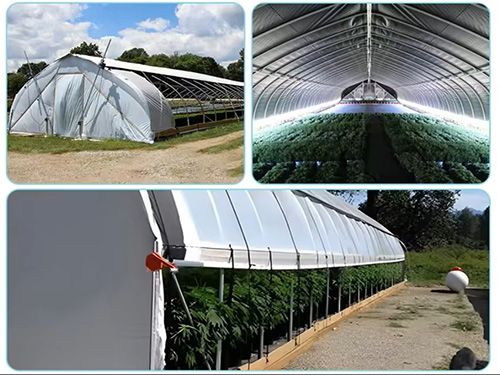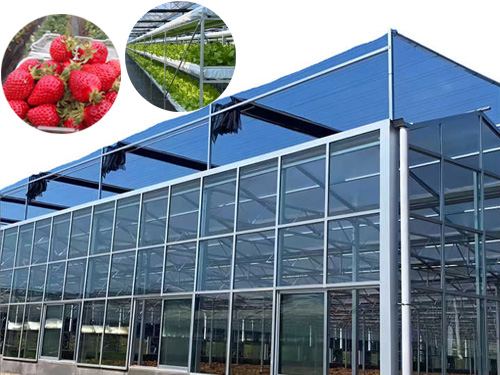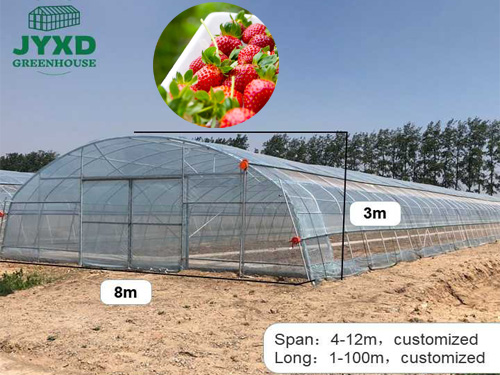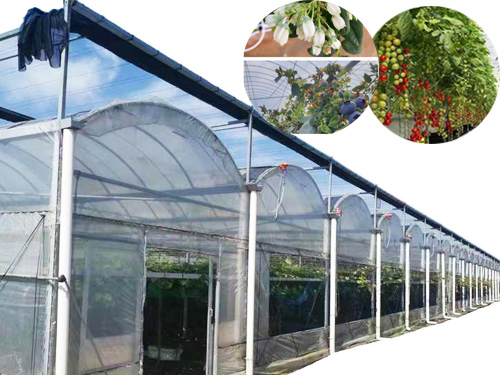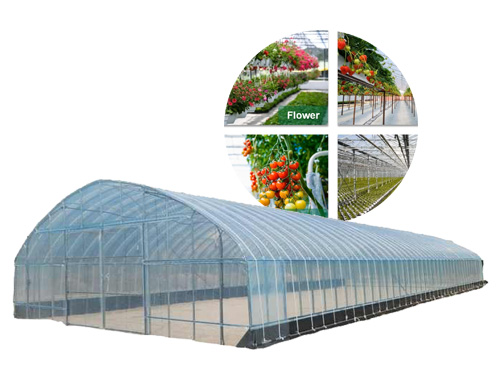NEWS DETAILS
NEWS INFORMATION
Hydroponic Greenhouses: Benefits and Practical Applications of Soilless Cultivation
AUTHOR:jyxd-greenhouse DATE:2025-03-04 08:15:40 HITS:153
Hydroponic greenhouses are revolutionizing the way we grow crops by eliminating the need for soil. This innovative method of soilless cultivation offers numerous advantages, including more efficient use of water and nutrients, faster plant growth, and the ability to grow in controlled environments year-round. As the demand for sustainable and resource-efficient agricultural practices grows, hydroponic greenhouses have become an essential solution for commercial and research applications. This article explores the benefits of hydroponic greenhouses and their practical applications in modern agriculture.
1. What is Hydroponic Greenhouse Cultivation?
Hydroponics is a method of growing plants without soil, using nutrient-rich water solutions to deliver essential nutrients directly to plant roots. In a hydroponic greenhouse, plants are typically grown in containers or on growing platforms, where their roots are immersed in or exposed to a nutrient solution, rather than being planted in traditional soil. This controlled environment allows for year-round cultivation, offering a range of benefits over conventional soil-based farming.
2. Key Benefits of Hydroponic Greenhouses
Water Efficiency
Hydroponic systems use significantly less water than traditional soil-based farming. In a hydroponic greenhouse, water is recirculated, meaning it is reused instead of being drained away, reducing overall water consumption. This is especially beneficial in areas with limited water resources, where traditional farming may not be sustainable.
Faster Plant Growth
Plants grown in hydroponic greenhouses typically experience faster growth compared to those grown in soil. This is because the nutrients are directly available to the plants in a water-soluble form, leading to more efficient nutrient uptake. Additionally, since the growing environment is controlled, plants can grow year-round, free from the limitations of seasonal weather changes.
Space Efficiency
Hydroponic systems are highly space-efficient. Vertical hydroponic farming, for example, utilizes stacked layers to maximize the use of space, making it possible to grow a large number of plants in a small area. This is particularly useful in urban environments or areas where land availability is limited.
Reduced Pest and Disease Risks
Since hydroponic systems do not rely on soil, they are less prone to soil-borne pests and diseases. This means fewer chemicals are needed for pest control, making hydroponic greenhouses a more environmentally friendly option for crop cultivation. Furthermore, plants grown in a hydroponic greenhouse are less likely to face competition from weeds, which can often be a challenge in traditional farming.
Consistent Crop Quality and Yields
Hydroponic systems provide optimal growing conditions for plants, leading to consistent crop quality and higher yields. By controlling variables such as light, temperature, humidity, and nutrient levels, growers can ensure that plants receive the ideal conditions for growth, resulting in healthier plants and more abundant harvests.
3. Types of Hydroponic Systems Used in Greenhouses
There are several hydroponic systems commonly used in greenhouse environments, each with its own advantages depending on the type of crop being grown and the available space.
Nutrient Film Technique (NFT)
In this system, a thin film of nutrient-rich water flows over the plant roots, providing them with constant access to the necessary nutrients. NFT systems are often used for growing leafy greens like lettuce and herbs.
Deep Water Culture (DWC)
In a DWC system, plant roots are submerged in a nutrient solution, allowing them to absorb water and nutrients directly. This system is particularly well-suited for larger plants like tomatoes and cucumbers.
Wick System
A wick system uses a passive method to transport nutrients to plant roots. The nutrient solution is drawn up through a wick material, such as cloth or rope, which brings water and nutrients to the plant roots. This system is ideal for smaller-scale operations and less water-intensive crops.
Ebb and Flow (Flood and Drain)
In an ebb and flow system, plants are periodically flooded with nutrient solution, which then drains back into a reservoir. This cycle promotes healthy root growth and is effective for a variety of crops, including herbs, vegetables, and flowers.
4. Practical Applications of Hydroponic Greenhouses
Commercial Crop Production
Hydroponic greenhouses are increasingly being used for commercial production of high-value crops, such as leafy greens, herbs, tomatoes, and strawberries. By controlling the growing environment, farmers can increase crop yield and quality while reducing the environmental impact associated with traditional farming practices. These systems are particularly beneficial for growing crops in urban areas, where land is limited but demand for fresh produce is high.
Research and Development
Hydroponic greenhouses are also widely used in agricultural research, particularly for studying plant growth and testing new farming techniques. Researchers can use hydroponic systems to explore plant responses to different nutrient levels, light conditions, and environmental factors without the complications of soil variability. This controlled environment is ideal for testing new crops and growing techniques, including genetically modified plants and innovative pest control methods.
Educational Applications
Hydroponic systems are increasingly being integrated into educational programs, allowing students and institutions to explore sustainable farming methods hands-on. Hydroponic greenhouses provide an excellent opportunity for learning about plant biology, nutrient management, and environmental control, while also introducing students to cutting-edge agricultural technologies.
5. Environmental Impact and Sustainability
Hydroponic greenhouses offer significant environmental benefits compared to traditional farming. By reducing water usage, eliminating the need for pesticides, and enabling year-round production in small spaces, hydroponics supports more sustainable agricultural practices. Additionally, because hydroponic systems are often integrated into urban areas, they help reduce the carbon footprint associated with transporting food from rural farms to city markets.
6. Challenges and Considerations for Hydroponic Greenhouse Farming
While hydroponic greenhouses offer many benefits, they do come with certain challenges. These include the initial setup costs for hydroponic systems, the need for careful monitoring of nutrient levels, and the requirement for technical knowledge to maintain the systems. However, as technology advances and the demand for sustainable agriculture increases, the barriers to entry are becoming more manageable.
Conclusion
Hydroponic greenhouses represent the future of sustainable agriculture. By eliminating the need for soil and offering controlled growing conditions, they provide significant benefits in terms of water efficiency, space utilization, and crop yields. With a variety of hydroponic systems available and increasing interest in soilless cultivation, these greenhouses are transforming the way we grow food, making it possible to produce fresh, high-quality crops year-round.
Would you like more information on setting up a hydroponic greenhouse or choosing the right system for your needs?
Hebei Juyou Xinda Greenhouse Facilities Co.,Ltd.
Copyright © 2024-2025 https://www.jyxd-greenhouse.com. All Rights Reserved Hebei Juyou Xinda Greenhouse Facilities Co.,Ltd.Copyright





 Current Location:
Current Location:


